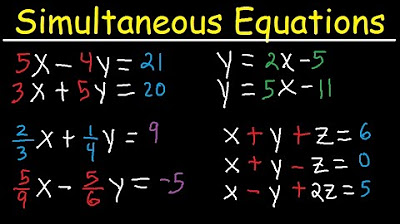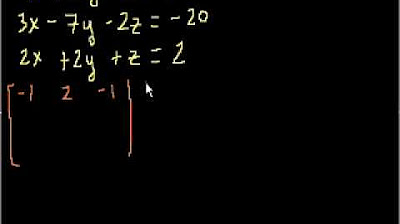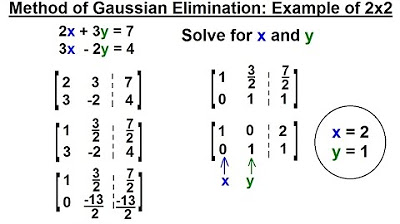Elimination Method For Solving Systems of Linear Equations Using Addition and Multiplication, Algebr
TLDRThis video tutorial explains how to use the elimination method to solve systems of linear equations with two and three variables. Starting with simple examples, it demonstrates the step-by-step process of adding equations to eliminate variables, thereby finding the values of x and y. It progresses to more complex examples involving three variables, detailing how to combine equations to cancel out variables and solve for the unknowns. The tutorial emphasizes practical application, guiding viewers through each step to ensure a thorough understanding of the elimination method.
Takeaways
- 📚 The video explains how to use the elimination method to solve systems of linear equations.
- 🔍 To solve a system with two variables, you need two equations, and the method involves adding them to eliminate one variable.
- ✂️ The elimination method simplifies equations by canceling out variables, making it easier to find the values of the unknowns.
- 📈 The first example demonstrates solving a system with equations 2x + y = 5 and 3x - y = 5, leading to x = 2 and y = 1.
- 📝 For the second example, the least common multiple is used to adjust equations so that adding them cancels out the y variable, resulting in x = 2 and y = 3.
- 📚 The video also covers solving systems with three variables, which involves combining two equations at a time to eliminate one variable and simplify the system.
- 🔢 In the three-variable example, the equations are x + y + 2z = 9, x - y + z = 2, and 2x + y - 3z = -5, leading to the solution x = 1, y = 2, and z = 3.
- 📐 The process involves finding the least common multiple for coefficients of variables to be eliminated and multiplying equations accordingly.
- 📉 After eliminating one variable, the remaining equation is used to find the value of the other variable(s).
- 📌 The video encourages viewers to pause and attempt the examples themselves, promoting active learning.
- 🎯 The final takeaway is that the elimination method is a systematic approach to solving linear equations, applicable to systems with two or three variables.
Q & A
What is the elimination method used for?
-The elimination method is used for solving a system of linear equations by adding or subtracting equations to cancel out one variable at a time, simplifying the system to find the values of the variables.
How many equations are needed to solve a system with two variables?
-Two equations are needed to solve a system with two variables, as each equation provides one piece of information that can be used to find the values of the variables.
In the example given, what is the first step to solve the system of equations 2x + y = 5 and 3x - y = 5?
-The first step is to add the two equations together to eliminate the variable y, which results in 5x = 10.
What is the value of x found in the simple example with equations 2x + y = 5 and 3x - y = 5?
-The value of x is found to be 2 by dividing both sides of the equation 5x = 10 by 5.
Once the value of x is known, how is it used to find the value of y in the simple example?
-The value of x is substituted back into one of the original equations, and the equation is solved for y. In this case, substituting x = 2 into 2x + y = 5 gives y = 1 after simplification.
What is the least common multiple (LCM) used for when solving a system of equations with the elimination method?
-The least common multiple is used to find coefficients for the variables in the equations that will allow them to cancel each other out when the equations are added or subtracted.
In the example with equations 5x + 4y = 22 and 7x + 6y = 32, which variable is chosen to cancel out?
-The y variable is chosen to cancel out by manipulating the equations so that when they are added together, the y terms become 12y and -12y, which sum to zero.
How are the equations manipulated in the second example to cancel the y variable?
-The first equation is multiplied by 3 and the second equation is multiplied by -2 to create terms of 12y and -12y, respectively, which cancel each other out when the equations are added.
What is the solution to the system of equations 5x + 4y = 22 and 7x + 6y = 32 after using the elimination method?
-The solution to the system is x = 2 and y = 3, found by first eliminating y and then substituting the value of x back into one of the original equations to solve for y.
What is the process for solving a system of equations with three variables as described in the script?
-The process involves combining two equations at a time to cancel out one variable, then using the third equation to cancel the same variable and create a new equation with the remaining variables. This process is repeated until all variables are solved for.
In the example with three variables, what is the final solution for x, y, and z?
-The final solution for the system with three variables is x = 1, y = 2, and z = 3, found by systematically using the elimination method to solve for each variable.
Outlines
🔍 Solving a System of Linear Equations with Elimination Method
In this video, we'll learn how to use the elimination method to solve a system of linear equations with two variables. We start with the example of solving 2x + y = 5 and 3x - y = 5. By adding these equations, we eliminate the y variable and find x = 2. Then, substituting x back into the first equation, we find y = 1. This gives us the solution (2, 1). Next, we solve another system with equations 5x + 4y = 22 and 7x + 6y = 32 by finding the least common multiple of the y coefficients and adjusting the equations to cancel out y, leading to the solution (2, 3).
🧩 Solving a System of Linear Equations with Three Variables
We move on to solving a system with three variables: x + y + 2z = 9, x - y + z = 2, and 2x + y - 3z = -5. By combining pairs of equations to cancel out the y variable, we simplify to equations with only x and z. After multiplying these simplified equations to align the coefficients of z, we eliminate z, solve for x, and then substitute back to find z and y. This process gives us the solution (1, 2, 3). The video emphasizes the importance of methodically combining equations to systematically eliminate variables and find the values of x, y, and z.
Mindmap
Keywords
💡Elimination Method
💡System of Linear Equations
💡Variables
💡Least Common Multiple (LCM)
💡Equilibrium
💡Ordered Pair
💡Coefficients
💡Substitution
💡Solving for a Variable
💡Three-Variable System
Highlights
Introduction to the elimination method for solving systems of linear equations.
Explanation of the necessity of two equations to solve for two variables.
Demonstration of eliminating the y variable by adding two equations.
Solving for x by simplifying the equation 5x = 10.
Finding x = 2 by dividing both sides of the equation by 5.
Substituting x = 2 into the original equation to solve for y.
Calculating y = 1 by isolating y in the equation 4 + y = 5.
Presenting the solution as an ordered pair (x, y) = (2, 1).
Transition to solving a system with three variables.
Introduction of a second example with equations 5x + 4y = 22 and 7x + 6y = 32.
Strategy to cancel y variable by adjusting equations.
Finding the least common multiple (LCM) of 4 and 6 to be 12.
Multiplying the first equation by 3 and the second by -2 to eliminate y.
Solving the new equation 1x = 2 to find x = 2.
Substituting x = 2 back into the original equation to find y.
Calculating y = 3 after simplifying 22 - 10 / 4.
Solution for the second example presented as (x, y) = (2, 3).
Moving on to an example with three variables x, y, and z.
Combining equations to eliminate y and simplify to 2x + 3z = 11.
Using the third equation to further eliminate y and solve for x and z.
Finding the LCM of 2 and 3 to be 6 for further elimination.
Multiplying equations to eliminate z and simplify to 13x = 13.
Solving for x = 1 by dividing 13x = 13 by 13.
Substituting x = 1 into the equation to solve for z.
Calculating z = 3 after simplifying 11 - 2(1) / 3.
Finding the value of y by substituting x = 1 and z = 3 into the first equation.
Determining y = 2 to complete the solution (x, y, z) = (1, 2, 3).
Conclusion on solving systems of equations with 3 variables using the elimination method.
Transcripts
Browse More Related Video

Substitution Method For Solving Systems of Linear Equations, 2 and 3 Variables, Algebra 2

Simultaneous Equations - Tons of Examples!

Solving 3 Equations with 3 Unknowns

PreCalculus - Matrices & Matrix Applications (6 of 33) Method of Gaussian Elimination: 2x2 Matrix

Solving Systems of Equations With 3 Variables & Word Problems

Solving Systems of Equations By Elimination & Substitution With 2 Variables
5.0 / 5 (0 votes)
Thanks for rating: